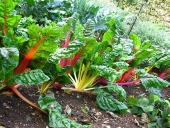Okay, so we have Lava Rock!
I've got 3 sizes of pumice (fine, medium, & large) plus a fine size of red scoria (otherwise known as cinders) to offer; both are porous lava rock with similar qualities
I'll ship up to 20 lbs worth at a time in 12x10x7" boxes (just shy of 1/2 cu.ft) for $22.47 (pumice) or $24.97 (scoria) plus shipping per box, and if you happen to be close enough to pick up larger quantities (from central PA, or
potentially southern upstate NY): you can save on shipping.
Just mooseage me here or through my website at
onmyownroots.com
Here's some great info about porous lava rock:
A perfect 100% natural planting media or ingredient
pumice has a neutral pH, and a natural white to gray color when dry
porous texture makes it lightweight, while rock nature holds its shape
acts as a rigid sponge to hold nutrients and water
excellent drainage for sensitive crops (succulents, bonsai, tree cuttings)
a permanent aspect of soil structure; not prone to break down
full of minerals from deep in the earth; any rock dust produced is a great addition to compost
In comparison to other porous Lava Rocks:
Pumice comes from the froth at the top of lava, while Scoria is solidified from the lava itself
Scoria is more acidic than pumice, as well as more dense and thus heavier
Though both are porous, pumice is light enough to float on water and scoria will sink
Pumice is more riddled with air pockets inside it to hold water, and thus dries out slower than Scoria
Scoria tends to be more harsh and angular, while pumice is more rounded and smooth
Pumice has some tendency to be dislodged when watering, and thus scoria works better as a top dressing
The darker colors of scoria warm up quicker in the sun to hold heat around roots
Darker colors of scoria also hide the dirty look of algae and moss better than pumice does
Red scoria gets its color from the iron it contains, Black scoria also contains magnesium rich minerals
sourced from a volcanic quarry on USA's west coast
use as is for cactus and succulents, or combine with other ingredients for an ideal potting mix
will not float to the top of a potting mix or smash between your fingers like perlite does
improves the quality and grow-friendly nature of any soil mix
excellent for use with hydroponic or aquaponic systems that keep plants watered but not waterlogged by capillary action
1/8" size is ideal for propagation trays; as the pot gets bigger, so can the rock size used within it
1/4" size is most common for horticulture use as a potting soil ingredient
larger sizes are great for large planters and indoor planting beds
weighs about 30-40 lbs to the cubic foot, which is just under about 7 gallons of volume
Thank you! 🙂









 But maybe just after it flowers, because you don't need that energy drain on a cutting.
But maybe just after it flowers, because you don't need that energy drain on a cutting. 







